Hidden Pain in Cats
Dr. Robin Downing, Downing Center for Animal Pain Management
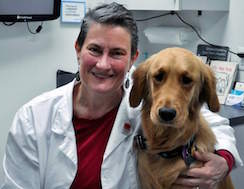 Cats may feel pain but there may be no obvious signs. Dr. Robin Downing specializes in pain and palliative medicine for pets and she explains why cats may not exhibit the signs of pain, or at least how humans perceive pain. Dr. Downing also discusses pain treatments for our furry friends. This segment is part of the Fear Free Expert Series.
Cats may feel pain but there may be no obvious signs. Dr. Robin Downing specializes in pain and palliative medicine for pets and she explains why cats may not exhibit the signs of pain, or at least how humans perceive pain. Dr. Downing also discusses pain treatments for our furry friends. This segment is part of the Fear Free Expert Series.
Dr. Downing states it's all about cats being masterful at hiding their pain. In order to understand this, we need to consider that cats are predators and when predators can no longer hunt, they become someone else's pray. This is really an evolutionary holdover that contributes to our dilemma, because we have an animal that is used to being in charge and when they can't be in charge, their task, as far as they're concerned, is to prevent others from knowing that they are weak and to prevent others from even thinking that they are weak. So they'll hide that weakness. This means they'll hide their pain until they just can't hide it anymore.
Another problem is that cats don't just purr when they are content, which is actually something that contributes to Dr. Downing's dilemma as a veterinarian. This is because cats that are in pain will often purr as a form of self-comfort. This is kind of like thumb sucking in infants or children. If a cat is purring when they are in pain, the owner can actually be deceived into thinking that they're just fine and that they're purring from contentment.
When Dr. Downing talks about pain in cats and how to detect it, whether she's talking with her colleagues or talking with cat owners, it all really boils down to being alert to any changes in their behaviors.
So what kinds of behaviors might we think about that could change in the face of pain? The most common that she sees are cats that no longer want to go vertical. So these are cats that used to sit in the windowsill and look at birds, or they used to jump on the furniture or the counters in the kitchen, or they used to sleep with the owners on their beds and now they're not doing those things.
However, Dr. Downing tells us she's had the occasional client tell her happily that their cat is no longer getting on the kitchen counter, but it bursts their bubble when they realize that they're not getting on the kitchen counter because they're uncomfortable.
Another important behavior for us to monitor that would lead us to think they might be in pain is unkempt hair coats. Cats are really fastidious creatures. They love staying clean. They love having a beautiful hair coat. But when they're in pain, they will either decrease their grooming, or they might stop doing it altogether. They start to look like they're wearing a rumpled suit and look unkempt. They might even develop mats in their hair.
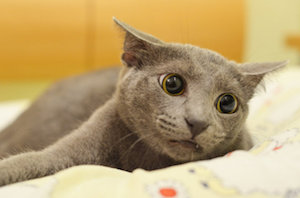 Other things for cat owners to be aware of is that they might see changes in how their cats like to be handled. Dr. Downing will occasionally hear a cat owner say their cat doesn't want them to pet them or touch them in a certain place, or they no longer want to be picked up. Some may say that their cat used to sit in their lap and now they only sit beside them.
Other things for cat owners to be aware of is that they might see changes in how their cats like to be handled. Dr. Downing will occasionally hear a cat owner say their cat doesn't want them to pet them or touch them in a certain place, or they no longer want to be picked up. Some may say that their cat used to sit in their lap and now they only sit beside them.
We may even see changes in eating or drinking behavior. They might not eat as well or as much or they might be off their drinking as well.
Another huge signal for us to watch for is their litter pan behavior. If it becomes uncomfortable for a cat to get in and out of a litter pan, even thought the cat may have been perfectly litter box trained his whole life, they may all of sudden start urinating and defecating in places they shouldn't. We may also see cats that no longer play with their toys or with the other pets in the household. Oftentimes a well-meaning cat owner will just chalk it up to their cat getting older.
Dr. Downing wants to remind everyone that old age is not a disease and when we see changes we think might be due to age, they actually might be due to pain. We may have a cat who was previously very happy and now they're crabby, or we may have a cat who used to want to be right where the action is and now when the grandkids come to the house, the cat disappears into a bedroom.
All of that slowing down or any changes in their activities of daily living are all signals to us to really look carefully for the possibility of pain.
In order to treat cats for pain, the first thing we have to think about would be the most common causes for pain. It's only by understanding the cause of the pain that we can even make a rational choice about treatment options.
The most common reason that we would find pain in a cat is actually chronic pain from osteoarthritis. Dr. Downing tells us about data from a study that came out of Texas A&M University College of Veterinary Medicine that lets us know that in cats across all ages, so it doesn't matter if they're very young or very old, about 20-percent of those cats are suffering from painful osteoarthritis. Then the number gets really interesting when we get to 10 years of age and older. We now know that greater than 90-percent of cats who are 10 years of age or older have evidence of osteoarthritis in at least one joint on an x ray. That's a huge number of cats having chronic pain from osteoarthritis.
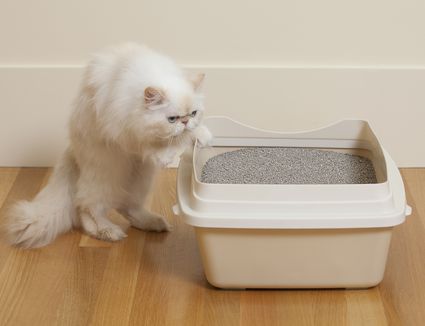 There are three other really important sources of pain for cats, and again, this is what leads us to understand that it's complex to treat cat pain, because we have to understand where it is before we can treat it.
There are three other really important sources of pain for cats, and again, this is what leads us to understand that it's complex to treat cat pain, because we have to understand where it is before we can treat it.
The first is oral pain from periodontal disease. Cats have this unique phenomenon that can happen where their immune system turns against the cats own teeth and makes holes in those teeth all the way down to the nerve. Those resorptive lesions can be excruciatingly painful. The periodontal disease by itself can be painful, but these lesions can be equally or even more excruciatingly painful. Cats also have a have a fairly high incidence of cancer in the mouth called oral squamous cell carcinoma, which is also really painful. A second additional pain phenomenon we see in cats is abdominal pain from either inflammatory bowel disease (IBD), pancreatitis, where the pancreas becomes very inflamed and super secretes digestive enzymes into the abdomen or kidney pain, because it is actually fairly common for cats to develop kidney stones, not bladder stones. Any human who's had kidney stones can tell you that can be very painful.
Finally, we have to consider bladder pain. A certain percent of cats will develop this condition that we now refer to as feline idiopathic cystitis. So breaking that down, idiopathic means we don't have a single cause that we can put our finger and cystitis means inflammation in the bladder. So idiopathic cystitis can leave cats with bladder spasms and incredible pain when they try to urinate and they can actually pass blood in their urine. This is a really challenging phenomenon to deal with.
The good news is that with appropriate pain medication and appropriate nutrition as well as stress management and by using tools like pheromones in the home, we can actually manage these kitties and restore them to comfort.
Visit Fear Free Happy Homes for tips on making your home fear free and to locate a Fear Free Veterinarian near you. Go to Fear Free Pets to become certified.
Listen and Explore the Fear Free Expert Series
Sea-furring Felines
Philippa Sandall, Seafurrers
 We remember the bold seafarers of yore, from Magellan to Shackleton, for their extraordinary exploits; new lands discovered, storms weathered and battles won. But somehow history has neglected the stalwart, hardworking species who made it all possible ... yes, the noble cat! Philippa Sandall joins us from down-under to describe these under appreciated sea-furring felines.
We remember the bold seafarers of yore, from Magellan to Shackleton, for their extraordinary exploits; new lands discovered, storms weathered and battles won. But somehow history has neglected the stalwart, hardworking species who made it all possible ... yes, the noble cat! Philippa Sandall joins us from down-under to describe these under appreciated sea-furring felines.
When you think of the sea voyages of the early days and you think about the animals that are onboard, your first thoughts are probably of parrots, because we have all heard of the pirates with a parrot on their shoulders. Next you might think about dogs and then all of the rodents on the ships, because they moved a lot of grains. That's when you might think about the cats that were brought on board to control the rodent population. Apparently cats were big "seafurrers."
Philippa Sandall is the author of "Seafurrers: The Ship's Cats Who Lapped and Mapped The World." Philippa explains that it is one of those books that's been a long time coming.
She tells us years ago she was chatting with a colleague who wrote serious books including biographies. They started talking about a man called Matthew Flinders, who circumnavigated Australia between 1801 and 1803 and he had a ship's cat that did that voyage with him, who was called Trim. So they were just chatting about Matthew Flinders and Trim and they had a nice conversation and that was that.
Not long after that, Philippa was walking on the beach and suddenly the word seafurrers popped into her head. She didn't know where it came from, but it did and she couldn't let it go. You know how it is when you get these ideas and you can't let them go. She then thought she would have a look and see what there is out there about ships' cats, because she's always liked cats and had always had a cat. She was then absolutely gobsmacked to discover a whole world of these cats. There are some quite famous ones on the Internet. Philippa says a lot of people retell the stories, but she was more interested in what the stories of the people who sailed with them were. That's where Seafurrers came from.
In Seafurrers, an able sea cat named Bart sets the record straight at last. Philippa says that Bart felt it was time for the seafurrers' view of maritime history. Philippa is not quite sure Bart actually ever went to sea, but he has a lot of opinions about it.
 So what does Bart think about the whole water thing? It's no surprise that cats aren't big on water. He said the cats didn't do laps and wouldn't jump into a pool and go swimming necessarily, but they can swim if they have to. This is really one of the most fascinating things that came out of the book and the research is the number of times cats took a dive unexpectedly into the deep blue sea. Surprisingly, the captains stopped the ships and some even dived in the sea to rescue them. Philippa says they wouldn't necessarily do that for a sailor, but they did for the ships' cats because the cats were good for pest control.
So what does Bart think about the whole water thing? It's no surprise that cats aren't big on water. He said the cats didn't do laps and wouldn't jump into a pool and go swimming necessarily, but they can swim if they have to. This is really one of the most fascinating things that came out of the book and the research is the number of times cats took a dive unexpectedly into the deep blue sea. Surprisingly, the captains stopped the ships and some even dived in the sea to rescue them. Philippa says they wouldn't necessarily do that for a sailor, but they did for the ships' cats because the cats were good for pest control.
Philippa explains that 3,000 plus years ago they didn't have the things we have today for pest control, so they used cats.
Besides doing great pest control, these cats also provided a lot of comfort. Philippa thinks that when you start to look at the photographs, you see and you read some of the stories, you see that simply having a pet was incredibly important for sailors on long voyages, far from home. It was something to talk to and something that slept on the end of their bed.
Some of the stories in Philippa's book also talk about things like the cat that helped catch the flying fish that flew over the side. She thinks that while some of the stories might be on the taller side, these cats still provided a lot of entertainment. The sailors even taught them tricks so they would jump through hands. These cats were just good loyal shipmates.
Plus, as Bart would say, they're low maintenance and they provide an entire catch and clean up service when it comes to pest control. It wasn't like you had to put out a trap and then you had to remove the rat, these cats did the whole job.
Also, these cats looked after themselves. They washed themselves and they dealt with their own waste. When you start reading about dogs at sea, there was a huge amount deck washing that had to take place to wash off the poop. However, with cats, you never read about this. So they obviously managed to find someplace to bury their waste and deal with it. Cats were extremely low maintenance, modest shipmates.
Visit Website
 When Pet Food Is Medicine -Dr. Debbie
When Pet Food Is Medicine -Dr. Debbie
Proper pet nutrition is more than just diet choices for the healthy pet. It's even more important to properly feed the sick pet or those with chronic diseases. What you put in your pet's food bowl can help, or harm, his ability to cope with illness.
Peek into your average veterinary office and you'll likely find one or more brands of therapeutic diet foods created to manage pet specific pet health conditions. Veterinarians prescribe therapeutic diets to help pets with kidney disease, diabetes, pancreatitis, weight loss or heart disease. Special digestive diets may focus on hypoallergenic ingredients, fiber content or fat levels. Some diets prevent or dissolve mineralized stones in the urinary bladder. There are even diets to keep the spring in your arthritic dog's step and diets to aid in treating pets with cancer.
The grandfather of veterinary nutrition was Dr. Morris who in 1940 designed a diet to improve longevity of his dog, Buddy, who was a seeing-eye dog battling kidney disease. His efforts led to the introduction to Hill's K/D diet, a favorite diet used today for dogs and cats with kidney dysfunction. Today many more diets and conditions are addressed by companies such as Science Diet, Royal Canin, Purina and Iams.
As a veterinarian I recognize the value that therapeutic diets lend to managing my patients' health. But my strongest testament to their value is as a doggie momma who feeds a therapeutic diet to my own dog, Magnum.
My Labrador Magnum suffers from food allergies with frequent facial skin infections, bad skin odor, scratching and unpleasant gastrointestinal signs with diarrhea and flatulence. After several diet trials with various hypoallergenic diet approaches, he now thrives on a rabbit based therapeutic diet by Royal Canin. His doggie kisses are sweeter smelling now, he's content and he isn't a walking gaseous explosion anymore.
But be prepared to dig deeper in your wallet for therapeutic diets. The research behind these foods will cost the consumer more than average pet foods. Just look at the example of Magnum's food. This diet runs $86 for a 25-pound bag of dry food. This sure isn't cheap. But the investment can pay off in lower medical costs and fewer veterinary visits, justifying the additional cost. In Magnum's case, we are able to avoid continued treatment of skin infections, thereby avoiding medication use and he is spared incessant itching.
 Some pet owners turn to home cooked diets in order to avoid the costs of therapeutic diets. Without guidance and veterinary nutrition analysis, pet owners may risk shortchanging their pet's nutrition. One research study identified that over 90-percent of home prepared diets for sick pets failed to be nutritionally adequate. Quality ingredients aren't cheap and a well-produced home cooked diet often ends up costing far more to prepare than commercially produced therapeutic diets.
Some pet owners turn to home cooked diets in order to avoid the costs of therapeutic diets. Without guidance and veterinary nutrition analysis, pet owners may risk shortchanging their pet's nutrition. One research study identified that over 90-percent of home prepared diets for sick pets failed to be nutritionally adequate. Quality ingredients aren't cheap and a well-produced home cooked diet often ends up costing far more to prepare than commercially produced therapeutic diets.
If your veterinarian recommends nutritional management with a therapeutic diet, discuss all the options with your doctor. Inquire about different brands and sizes of food packages available, as many options are available. Get your money's worth on these diets by following your veterinarian's recommendations. Avoid mixing therapeutic diets with regular foods. This only hinders your pet's results and give you a false sense of saving money by making the food last longer.
As for Magnum, I choose to feed him his therapeutic diet and avoid popping pills into him. That's my gauge of a therapeutic diet success - food that serves like medicine in the doggie bowl, but without the hassles.
Featured veterinarian known as "Dr. Debbie" on national pet radio program, Animal Radio. Ebook author of "Yorkshire Terriers: How to Be Your Dog's Best Friend"; "Pugs: How to Be Your Dog's Best Friend"; "Mini Schnauzers: How to Be Your Dog's Best Friend"; and "Shih Tzu: How to Be Your Dog's Best Friend." Dr. Debbie's books.
Visit Website
5 Things To Know About Pet First Aid
Robert Semrow, Listomania
 April puts a spotlight on National Pet First Aid Awareness. As a co-author on an upcoming Pet Safety and Pet First Aid book, I can't help but highlight this. Here are some of the basics that all pet parents should know.
April puts a spotlight on National Pet First Aid Awareness. As a co-author on an upcoming Pet Safety and Pet First Aid book, I can't help but highlight this. Here are some of the basics that all pet parents should know.
Let's start with prevention, as that is best thing you can do for your pet. When I'm asked about how to be prepared for first aid situations, I always respond that prevention is the best and often simplest thing you can do and it takes much less stress and effort than engaging in pet first aid. So know your pet's environment, indoors, outdoors, hiking trails, etc., and anticipate what may cause a potential hazard for your pet. This will also help you prepare for what pet first aid situations may occur and what supplies you may need.
One of the best things anyone can do is to get themselves some education about Pet First Aid. And yes, there are differences in pet first and human first aid. I don't want anyone to feel uneasy about providing care to a pet in need, so let me reassure you that it's not any more difficult than human first aid, it just has some differences that can be critical. So take a course from an expert in pet first aid, learn CPR and other techniques before you ever need them.
Next, build your pets their own pet first aid kit. You should have a kit for every member of your family, including your pets. Again, if you are bi-petual and have different species of pets, have a kit for each of those species. Many items work for both cats and dogs, but not always.
One of the most important things to know about pet first aid is that some things can be treated and cared for by you, the pet parent, and other things cannot and require medical attention immediately. When you aren't sure, always default to getting your pet safely to your veterinarian or emergency pet hospital as soon as possible. To do this, you must maintain calm and command of the situation. Your pet is counting on you to know what to do, how to do it and to do it in a calm and caring manner.
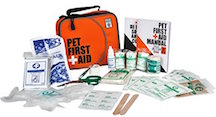 One of the other things you can do to assist and prepare for these situations is practice some of the common pet first aid situations. Now, I'm not recommending you mummify your pup, but if you have a similar sized stuffed animal, practice bandaging that stuffed animal. You can do this by practicing gently muzzling the injured stuffed animal and maybe even take a practice run at getting your pet to your local vet or emergency center. If it doesn't go smooth in a practice run, it's not going to in an emergency situation. Finally, always be aware of where emergency care is in relation to your pet's locale. Know the hours, the phone number, etc. It will save not only time, but also potentially your pet's life.
One of the other things you can do to assist and prepare for these situations is practice some of the common pet first aid situations. Now, I'm not recommending you mummify your pup, but if you have a similar sized stuffed animal, practice bandaging that stuffed animal. You can do this by practicing gently muzzling the injured stuffed animal and maybe even take a practice run at getting your pet to your local vet or emergency center. If it doesn't go smooth in a practice run, it's not going to in an emergency situation. Finally, always be aware of where emergency care is in relation to your pet's locale. Know the hours, the phone number, etc. It will save not only time, but also potentially your pet's life.
Pet first aid is something every pet owner should know. Your pets are counting on you for their care and their health.
Share your thoughts on pet first aid on our Animal Radio Facebook Page.
Visit Website
 The Dogfather's Grooming Tip with Joey Villani
The Dogfather's Grooming Tip with Joey Villani
Cutting Your Cat's Nails
Joey, the Dogfather, has turned into the "Cat Daddy" today. The reason why he wanted to talk about cats is that he was at a friend's family's house who has an older cat about 20 years old.
They told Joey that their cat hadn't walked really well for about four months. Joey started thinking that that cat was just old, but was still sweet as ever and purring away.
Joey then decided to look at the cat's pads. You always hear everyone talk about clipping a dogs nails all the time, but even Joey never talks about cat's nails very much. Joey doesn't feel people are being neglectful when they disregard a cat's nails, he feels that they just don't know that they should also be clipped.
Just like a dog, cat's nails continue to grow and can curl underneath into the pads. People don't think about this, because when a cat sharpens their nails, that is usually good enough to take care of them. However, in some cases, some cats don't do it or their nails just grow excessively. So what happened to this particular cat is something that happens often. This isn't an isolated case. Joey has seen this a lot over the years because he has groomed lot of cats.
So when he looked at this cat's pads, every single nail on all feet were grown into the cat's pads. Luckily Joey lived close by and was able to run home and get his cat nail clippers. He came back and cut them, even though they were a good way into the pad. The cat let Joey pull the nails out even though they bled like crazy. Two days later, that cat is walking perfectly fine.
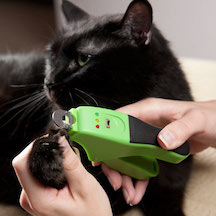 So this is one thing you want to check, even though you might get nervous because you don't want to get bit and you don't want to get scratched. However, if you have a good cat, you can do it yourself. If you don't have good cat, you need a partner, because someone is going to have to scruff the cat. One person will scruff the cat and hold the back feet while the person cutting the nails controls the front legs. You have to be able to trust your wingman, because you don't want your cat's teeth sinking into your hand. It will not hurt your cat to be scruffed. In fact, more damage is happening by letting those nails grow too long than the two minutes of cutting the cat's nails and being scruffed and held by the back legs.
So this is one thing you want to check, even though you might get nervous because you don't want to get bit and you don't want to get scratched. However, if you have a good cat, you can do it yourself. If you don't have good cat, you need a partner, because someone is going to have to scruff the cat. One person will scruff the cat and hold the back feet while the person cutting the nails controls the front legs. You have to be able to trust your wingman, because you don't want your cat's teeth sinking into your hand. It will not hurt your cat to be scruffed. In fact, more damage is happening by letting those nails grow too long than the two minutes of cutting the cat's nails and being scruffed and held by the back legs.
If you don't want to do this, have your veterinarian do it, or even a groomer, which is less expensive. There are even mobile units that come to your house. But if the situation is real bad and the nails are growing into the pads, be sure to take your cat to the veterinarian and let them take care of it.
Animal Radio News - Lori Brooks
 Homeless Man Freezes To Death With Feral Colony
Homeless Man Freezes To Death With Feral Colony
A homeless Chicago man who literally froze to death because he wouldn't leave the feral cats he cared for was honored. It's said that for more than ten years, Antonio Garcia lived in the tiny alley in Chicago where he slept in a small shack made from old wood scraps and old mattresses. He shared his home with a colony of nearly 40 feral cats. Antonio, who was 64, would always say, "If my cats are fed, my heart is full." However, during some brutally cold weather, neighbors noticed they hadn't seen Antonio. Police found him inside his shack surrounded by several of his cats. A group called "Antonio's Friends," took over care of the cats, including having them vaccinated, spayed or neutered and built outdoor shelters for them. Volunteers even set up a privacy fence to keep people out of the cats' living area and purchased heated water bowls, feeding stations and a surveillance camera so that they can always keep an eye on Antonio's alley cats.
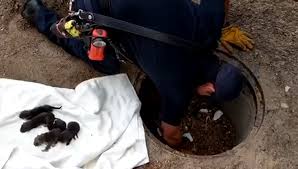 Firefighters Thought They Were Rescuing Puppies
Firefighters Thought They Were Rescuing Puppies
Firefighters in Colorado Springs say they were pretty surprised to learn that the littler of "puppies" they rescued from a storm drain were actually baby foxes. Before learning they actually had baby foxes in their care, they were taken to a veterinary hospital where they were told the tiny little things were really newborn red fox kits. Kits are what baby foxes are called, like baby cats are kittens and newborn dogs are puppies. The decision was then made and the kits were returned to the same storm drain where they had been pulled from, with hopes the mother fox would return to the area and take over her duties.
Track Your Pet While Flying
Airlines have been in the news so much lately for problems involving animals. If all those stories have you fearful of putting your pet on a plane, Technology Company Unisys has developed a way for pet owners to track and even keep in touch with their pet when flying. The Digi-Pet system uses sensors and the Internet of Things (IoT) to keep animals safe. Here's how it works: sensors monitor environmental factors like temperature, oxygen levels, vibration and light so the Digi-Pet system can automatically send alerts to pet parents and airline staff if there are any issues while the animal is traveling in the cargo hold. Through a subscription service, Digi-Pet also allows pet owners to keep in touch with their pets through live video streaming, photos and voice exchanges, via an app that works on smartphones and tablets. This is especially great for large dogs that must travel in the cargo hold. The system uses sensors to provide pet owners with full visibility of their pet's comfort and the environmental conditions, as well as enabling them to talk to their pet.
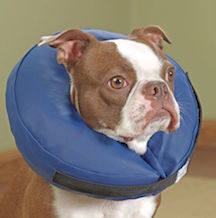 Which E-Collar Is The Best For Your Pet?
Which E-Collar Is The Best For Your Pet?
Because every pet will likely need to wear a cone at some point in their life, TheWirecutter.com completed an in depth review of cones or e-collars. Here is how they selected the winners in every category you can think of including plastic cones, inflatable cones, soft cones, padded cones, etc. They researched a variety of styles and designs of 21 models. They focused on those that had the best third-party reviews and were priced around $20 to $40 depending on the size. They also had to be available at multiple retailers and were easy to clean. From those, they found 10 that ranked highest. The overall winner was the Remedy + Recovery E-collar, which TheWirecutter.com said was more comfortable than most plastic e-collars thanks to its padded edges. It's also long enough to prevent most pets from licking wounds. It scratches less than other cones, comes in five sizes that accommodate most animals and is easier to assemble than the cones most vets sell. However, they said The Remedy + Recovery isn't ideal for pets with short noses, or those smooshed face breeds, which might need an inflatable collar instead. For cats and those short nosed breed dogs, they rated the Kong Cloud Collar, which is inflatable, as best. For less active pets, try the Calm Paws Caring collar which they say is more comfortable to wear in a crate or while sleeping and also has a wider range of view than other cloth e-collars. A final note, the consulting veterinarian to the review said the best e-collar alternative for cats who can get around an e-collar to lick places they shouldn't, is a baby t-shirt. Just remember to buy enough baby t-shirts so that you can change and wash them as often as your vet recommends.
 Listen to the entire Podcast of this show (#1166)
Listen to the entire Podcast of this show (#1166)





